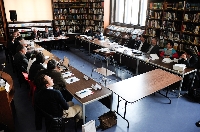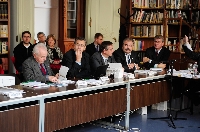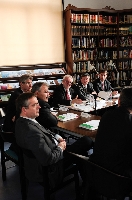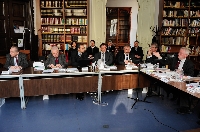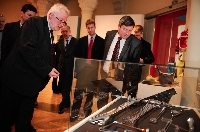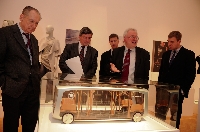The venue was chosen for a good reason: the Hungarian Design Award 2012 exhibition, which has displayed works with a major emphasis on innovation, provides an excellent opportunity for attracting the attention of professionals, the general public as well as participants in the economic sector, in industry, and R+D decision-makers to the value-creating potential of design, and furthermore to raise awareness in regard to the importance of design in innovation policy. These must be regarded as priority issues at national and EU levels since the creative industries that are developing at a dynamic pace may well contribute to the strengthening of the economy.
In his introduction Dr László Pósán, the chairman of the committee, stated that an R+D+I-based renewal built on technological innovation is crucial for increasing competitiveness. Now only those innovative projects that can link together the most diverse professional areas and communities can be truly successful economically.
Dr Miklós Bendzsel, the invited proponent of the meeting, said, "According to estimates, Europe's close to 410,000 qualified designers contribute to the generation of an annual 36 billion EUR revenue. He added that the creative industries and design have potential not only on a European but also on a national level. The creative industries are regarded as a key sector in Hungary; therefore, they should be strengthened and further developed. By exploiting the innovation power of design the large companies and SMEs, which are the driving force of the Hungarian economy, could gain numerous advantages. In order to facilitate this process besides international relations and support from Brussels, a stimulating domestic environment is also necessary."
In his speech Mr Bendzsel, who is the president of the Hungarian Intellectual Property Office and the Hungarian Design Council, briefly introduced the operation and scope of activities of the Hungarian Design Council - which supports the creative industries gaining ground -, highlighted its most important objectives, and, linked to its achievements, quoted some model examples illustrating the diversity of design and the stimulating power of innovation. In his international overview Mr Bendzsel talked about the 21 strategic recommendations made by the European Design Leadership Board published in September 2012, which represents one of the milestones in recent European design strategy initiatives to date. The report titled Design for Growth and Prosperity, which contains the policy recommendations, highlights the importance of a multifarious approach and the embedding of design in innovation policy. Among other things the board proposed the development of European Design Centres - already active in the business sector and the industry - to operate in an open network in order to enhance design awareness. The proposal also stresses the importance of strengthening the role of the public sector, in which the inclusion of design in public procurement projects is seen as one of the highlighted steps. In addition to these changes, the board members regarded it as necessary that an increasing number of European companies lead the way in the area of design awareness and thus encourage other market players. The members also underlined the need for design learning to become accessible to all European citizens through being included in general, vocational and higher education. The 12 EU Member states that joined most recently are represented in the Leadership Board by Dr Miklós Bendzsel.
The participants at the meeting were given a guided tour of the exhibition during which Miklós Bendzsel and the designers introduced the projects.
Photo: Norbert Perness





